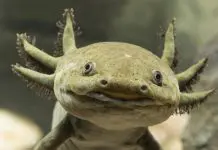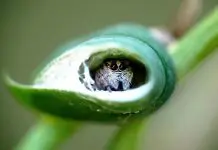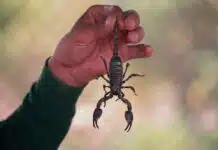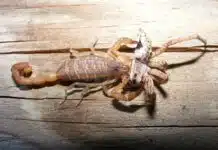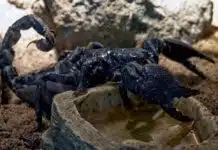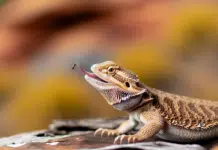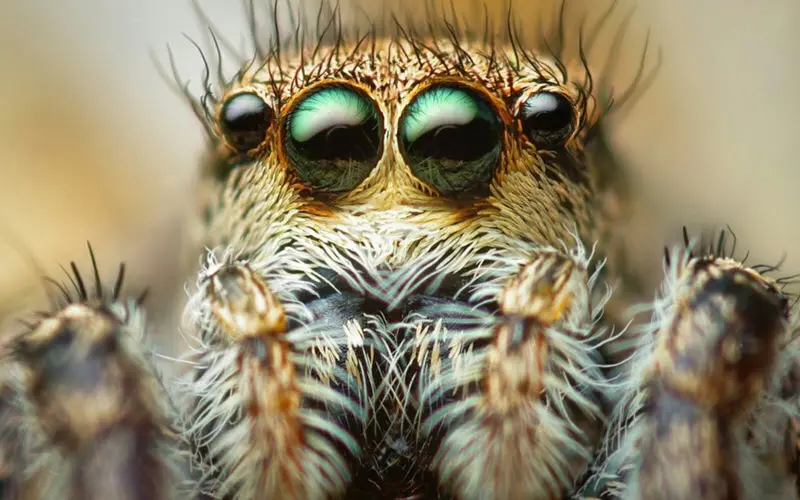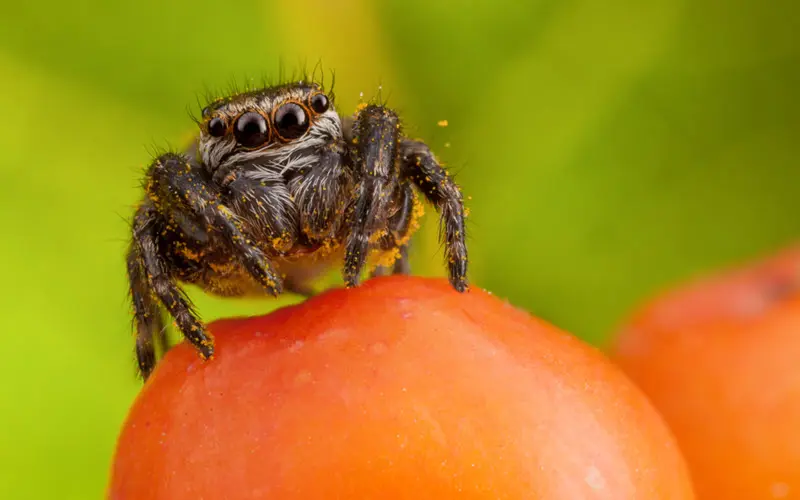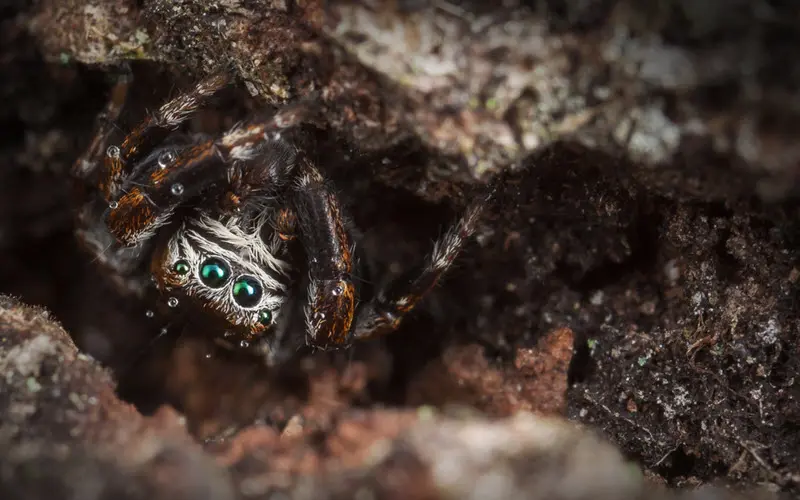Jumping spiders looks has an almost alien-like appearance that would be intrigued many if they were to stare at it face to face. A jumping spider has a distinctive set of eye arrangement that is unique to them.
They have this primary pair of large forward-facing eyes, two big ones in the middle, accompanied by a pair of smaller eyes each at both sides and the remaining pair to cover anything beyond sideways to the back of its body where it detects motion, a total of four pairs of eyes.
Measuring just under an inch, jumping spiders are quirky when they move about. Like most arachnid species, the jumping spider has four pairs of legs and most of them will pump additional blood pressure on its hind legs to boost their jumps.
Because of its irregular movements, it is hard to predict where it will jump to next.
Let’s jump into the world of jumping spiders and find out more about them below!
Contents
Jumping spider Facts
Jumping spiders are easy to identify once you have gone through videos and pictures of them long enough or even own one as a pet long enough. But if you have done neither both, how would you be able to tell the difference and identify a jumping spider?

Here are some physical attributes and some qualities to tell them apart.
- Jumping spiders jump, and unlike its other arachnid species, these spiders can really jump. Hence if you were to spot a spider that is jumping around, chances are that is already a jumping spider.
- Jumping spiders have four pairs of legs (total of eight legs)
- They have a furry or fuzzy appearance hairy overall
- Most of the time, they would be covered in color bands, stripes, and patterns
- They would have 4 front facing eyes that are quite distinctive, with the middle two being the largest.
- They have fangs as their own defense mechanism (Optional, if you are able to spot it)
If you are interested to learn in-depth and to really know how to properly identify a jumping spider, you may wish to read more here.
Their abilities – Jumping Power
These small arachnid species are able to jump at least 8 times their own body length by forcing blood through their hind legs at extremely high pressure to boost their powerful jump. As they are about to make their leap to jump, these jumping spiders will release a pair of silk thread which acts as their own harness to stabilize and solidify their jump. By pumping more blood into its legs, it allows them to stretch and greatly extend which explains why they are able to jump great distances.
Their features – How many eyes do they have?
These creepy crawlers have a total of four sets of eyes where it leverages on its undeniable powerful eyesight to accurately make sense of where its prey is and have a good gauge of the distance in order to know how much energy it needs to pounce and land directly onto its target.
This small arachnid has vision like no other insect or creature of its size. It has a total of eight eyes where four of them are front facing, two being the primary main eyes in the middle, along with smaller lateral eyes to the side each. The other two pairs of eyes are situated at its carapace where there are two to guard its back and the last pair in front of the two. The retina moves around while the lens of their eyes are fixed. This in return allows the jumping spider to have almost no blind spots at all, allowing a quicker reaction time which makes it hard for us to kill or catch it most of the time.
Their diet
Jumping spiders feed on generally insects, flies and bees as they are carnivorous. Certain few jumper species have also been known to include nectar and pollen in their diet too. It has also been studied that web-spinning jumping spiders and those that are dosed with venomed fangs have a larger appetite where they would prey insects that are much much bigger than their body sizes, such as grasshoppers and crickets. By pouncing onto them and injected their venom directly, it gives the jumping spiders adequate time to disassemble their limbs and consume them.
To understand more about a jumping spider’s diet, you may wish to check out Jumping spider gourmet guide here.
Their lifespan
How long do jumping spider live?
The salticidae family of the spider species, the jumping spiders can be found hiding from the cluster of leaves deep in the rainforests, to urban buildings and in between tight crevices of our homes, literally everywhere, and anywhere. But most of them thrive in tropical regions as those are the ideal living conditions for them.
In most cases, jumping spiders do not live for more than a year but with the right conditions and proper care given, they may live longer than their life expectancy. In colder climate countries, these jumping spiders may outlive their projected lifespan as they have to remain dormant for a couple of times and this would slow down their growing process overall.
How big do they get?
Jumping spiders typically do not exceed more than an inch in length. Their size varies from as small as 0.1cm to 2.5cm, where the largest recorded jumping spider species goes to the Hyllus Giganteus.
Jumping spiders predators
Here are some of the jumping spider’s predator that it would encounter through the course of their life.
- A bigger jumping spider
- Other bigger arachnid species
- Lizards
- Spider Wasp, also known as the Tarantula Hawks and other larger wasps
- Toads
- Monkeys
- Humans
- Fishes
- Bats
As most spiders are predators themselves, the jumping spiders are one of the smallest arachnid species there is in this world. If the jumping spider were to encounter or come face to face with any of its predators, their first natural instinct is to flee the scene and hide somewhere safe.
But if these little arachnids are being cornered, they have no choice but to fight, and most jumping spiders possess venoms that are being directly injected through their fangs if they were to get a good grip on their predators.
During this scenario, if the predator is large enough to withstand its venom, it is game over for the jumping spiders.
Some usual methods which are rarely recorded from the jumping spiders is that they are able to camouflage and blend in easily if they are out in a jungle or forest, making use of trees, wood barks and dirt, they will stay perfectly still and blend into what they feel is the closest to their colors they have and stay undetected.
Last but not least, the hairy fluff that we see all the time on some of the jumping spiders finally has its own moment to shine. These hairs can cause irritation and pain when rubbed against their predator’s eyes certain areas which would cause them itch and irritation, with just enough time for the spider to escape.
This would be some of the techniques that a jumping spider utilizes to get away from larger predators whenever they were to feel threatened.
Conclusion
In conclusion, although jumping spiders are smaller in size, they have these alien-like features enough to rid humans away from them. If you have attempted to catch a jumping spider but to no avail, it may be due to their almost perfect eyesight where they are able to have a perfect vision all around them which makes their response time that much quicker than us humans since they are light.
Even with such perfect anatomy and equipped with venomed fangs, these jumping spiders are not exactly on the top of the food chain. There are predators such as wasps, lizards, bigger species of spiders and toads that would ingest and consume the jumping spiders.
With a relatively short lifespan of less than a year, these jumping spiders have been mating and spreading their population across most continents which makes them quite common almost everywhere.
As much as they may seem like annoying pests to us, they are actually the ones who are helping us to rid our homes or surroundings of the real pests like flies.
I hope that you have learned or benefited from this article, feel free to share or leave a comment below under the comments section. If you feel that we have left out any parts or we should focus on certain areas that we have not covered, also let us know under the comments!

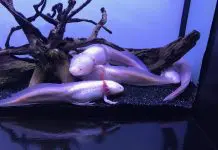

![Sick Axolotl, Fungus, Stress Symptoms [Axolotl Illness Guide 2025] Axolotl fungus](https://exopetguides.com/wp-content/uploads/2018/06/axolotl-218x150.jpg.webp)
